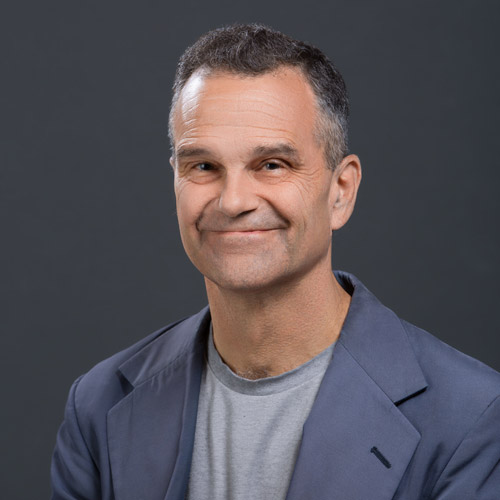294 Steps to Class
BU archaeology course: memorials’ meanings aren’t set in stone

Andrea Berlin’s class on monuments visits the Bunker Hill memorial and museum. Photos by Chitose Suzuki
Class by class, lecture by lecture, question asked by question answered, an education is built. This is one of a series of visits to one class, on one day, in search of those building blocks at BU.
Sweating, panting, pausing for breath, and occasionally taking the Lord’s name in vain, Andrea Berlin’s six students troop up the 294 steps of the Bunker Hill Monument. “You told me there were 275. You lied,” one tells the professor.
Their reward at the top is a spectacular view of Boston. Its citizens scurry below, but the group has come to Bunker Hill, to paraphrase the famous line uttered at the Revolutionary War battle here, not to see the whites of their eyes but the gray of the monument’s granite.
A College of Arts & Sciences professor of archaeology, Berlin treats her Memory in 3-D class, and some eavesdropping tourists, to a discussion about how this memorial—commemorating the 1775 battle and completed in 1842—evolved over time (it didn’t always have a museum on site) and what those changes say about the evolution of the monument’s meaning.
“In and of itself, the monument was enough” at first, Berlin expounds at almost 221 feet in the air. “What is it about modernity that has a problem with the unexplained spot?”
“Could that be part of living memory,” with later generations needing more explanation of a long-ago battle? Karissa Hurzeler (CAS’13) asks.
Referring to an 1825 oration by Daniel Webster at the laying of the monument’s cornerstone—a document they’d studied under a nearby shade tree before ascending—Berlin says that Webster’s sweeping rhetoric and ideas needed reducing “into bite-sized nuggets” for future visitors. “There came to be a felt need among the custodians of this place to get a story, the story, one story.”
Memorials are visual spectacles, opportunities for reflection on what’s being memorialized, and perhaps, as one of Berlin’s students notes, a shopping opportunity, courtesy of the gift stores attached to most memorials. To Berlin, they are also a series of stories and meanings, different for successive generations. Bunker Hill meant varying things to the combatants who fought the battle, to Webster and his audience (he invested the site of the militarily insignificant battle with a cosmic, eternal importance), and to her students in 2012, Berlin tells them. “We look at monuments as static, one-shot deals. They are not.”

That lesson and the class’s “unconventionality” are the course’s joys, says Jennifer Hunter (GRS’17). Visiting Bunker Hill alerted her to “its multiple meanings, which in turn inspired me to look at ancient memorials in a different light and caused me to recognize certain layers of meaning” missed before.
Multiple meanings, Berlin says in an interview, also attached to the civil rights movement of the 1950s and ’60s, which didn’t get a memorial until 1989. It wasn’t the movement’s noble achievement alone that got it memorialized, she argues—rather, baby boomers “needed to find something heroic about the generation that was post–World War II.” With a memorial, “you are cementing a point of view, and you are cutting out others…and you are ineluctably seeing the past through its immediate, present lens. There are lots and lots of great things that happen. They don’t all get memorials.”
Just last summer, New York Times columnist David Brooks made a similar point, dissing as “duds” most recent memorials. Brooks argued that today’s monument makers are skittish about memorializing power wielded in pursuit of noble goals. To Berlin’s mind, Maya Lin’s Vietnam Veterans Memorial, completed in 1983, marked a dividing line: “Nothing that visceral and landscape-oriented has been done since.”
Bunker Hill is but one monument studied in the course; others include ancient Roman and Greek memorials, the Vietnam Veterans Memorial, New York’s Ground Zero memorial, and the World War II Memorial in Washington. A good monument excites Berlin the way Christmas does a child. “Look look look look look—isn’t that cool?” she squealed while chauffeuring some of her students to Bunker Hill in her orange Honda Fit.
At least one passenger was less impressed, underwhelmed by the hill part of Bunker Hill. “I was picturing something a little—hillier,” he said. “This is an incline.”
The class will be offered next in fall 2013.
This Series
Also in
One Class, One Day
-
November 30, 2018
Breaking Bad Director Gives CAS Class the Inside Dope
-
October 31, 2018
Trump and the Press: We’ve Been Here Before
-
August 3, 2018
A Scholarly Take on Superheroes


Comments & Discussion
Boston University moderates comments to facilitate an informed, substantive, civil conversation. Abusive, profane, self-promotional, misleading, incoherent or off-topic comments will be rejected. Moderators are staffed during regular business hours (EST) and can only accept comments written in English. Statistics or facts must include a citation or a link to the citation.